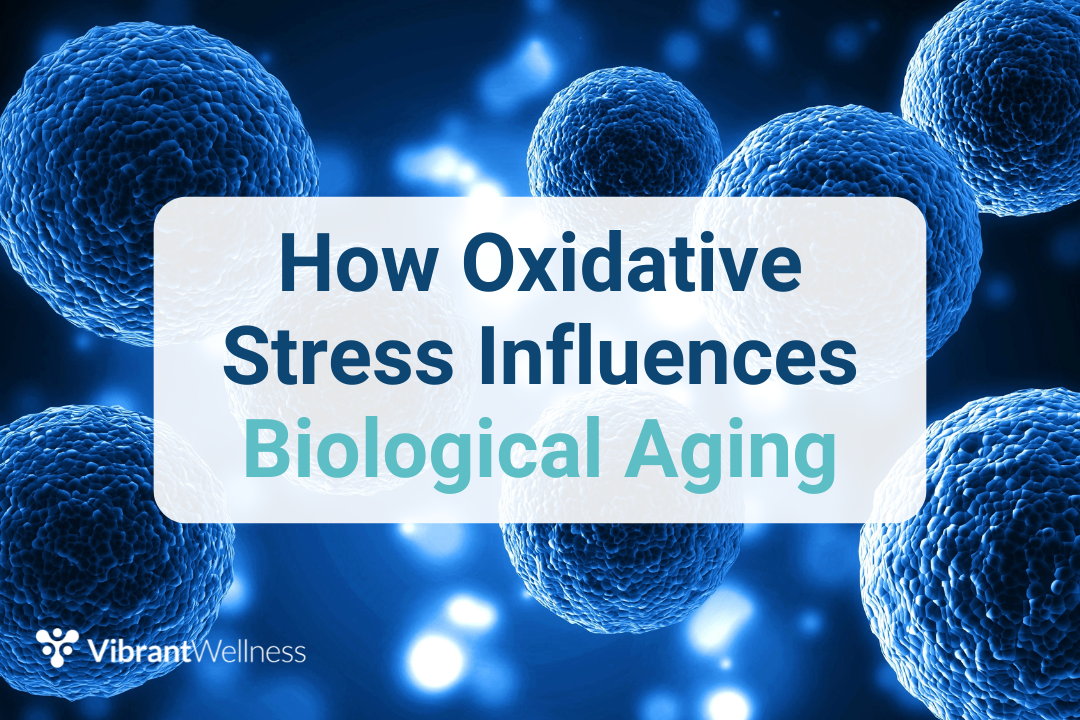Oxidative Stress: The Key to Unlocking Longevity
Clinically reviewed by Adair Anderson, MS, RDN, LDN
What role does oxidative stress play in longevity and health? Unpacking this question reveals the delicate balance between harmful oxidants and the body's antioxidant defenses—crucial components for understanding aging and disease progression.
In this article, we’ll explore the mechanisms of oxidative stress, its measurement through genetic and damage markers, and effective management strategies so you can take a proactive approach to improving healthspan and quality of life.
Table of Contents
What are the Primary Sources of Oxidative Stress?
Why is Managing Oxidative Stress Essential for Longevity?
How Can We Measure Oxidative Stress?
How Can We Reduce Oxidative Stress in the Body?
Cardiovascular Disorders and Oxidative Stress
Neurodegenerative Diseases and Oxidative Stress
Chronic Inflammation and Oxidative Stress
Understanding the Body’s Defenses: Genetics
Recognizing Oxidative Stress Damage Markers
How Can We Reduce Oxidative Stress in the Body?
What is Oxidative Stress?
Oxidative stress is an imbalance between the production of reactive oxygen species (ROS) and reactive nitrogen species (RNS) and the body’s antioxidant defenses, which can't effectively neutralize these reactive compounds.
Excessive oxidation can actively harm critical cellular components such as lipids, DNA, RNA, and proteins, which are the building blocks of the human body.
.png?width=600&height=600&name=Oxidative%20Stress%20Posts%20(5).png)
What are the Primary Sources of Oxidative Stress?
The body generates ROS and RNS continuously through essential processes like metabolism and immune responses. However, several external factors exacerbate oxidative stress, including:
- Lifestyle factors like tobacco and alcohol use activate inflammatory pathways that result in ROS and RNS production. This surge in reactive molecules can cause cellular damage and contribute to oxidative stress.
- Environmental exposure to toxins, heavy metals like lead and mercury, pollutants, and industrial chemicals can induce oxidative stress. Metals like lead and mercury can catalyze ROS production, while pollutants and industrial chemicals trigger oxidative stress by promoting free radical production, depleting antioxidants, and inhibiting their protective functions. Consider testing for these toxins with The Total Tox Burden to identify and eliminate specific factors contributing to oxidative stress.
- Certain medications, UV, and ionizing radiation contribute to oxidative stress by disrupting cellular balance, leading to excessive reactive oxygen species (ROS) production. These processes damage DNA, proteins, and lipids, overwhelming the body's antioxidant defenses.

In response to these stressors, the body activates a complex defense mechanism. Central to this defense are enzymes such as superoxide dismutase (SOD), catalase (CAT), and glutathione peroxidase (GPx), and molecules like glutathione, which collectively neutralize harmful reactive species, safeguard cellular integrity, and support overall cellular function.

Effectively managing oxidative stress can help protect the body's cells from premature damage, support healthy aging, and reduce the risk of age-related diseases.
This balance between mitigating oxidative stress sources and bolstering antioxidant defenses is central to living longer and better.
Why is Managing Oxidative Stress Essential for Longevity?
Research has increasingly linked oxidative stress to aging and age-related diseases. It causes extensive DNA damage and variations, impairs protein functions, and disrupts cellular signaling pathways.
This cellular and molecular damage accelerates the aging process, driving the onset of age-related diseases such as cardiovascular disorders, neurodegenerative diseases, diabetes, and inflammatory conditions.
Targeted interventions to manage oxidative stress and balance oxidants and antioxidants can greatly prevent and slow disease progression, emphasizing the importance of oxidative balance for healthy aging, longevity, and improved quality of life.

Cardiovascular Disorders and Oxidative Stress
Oxidative stress plays a pivotal role in cardiovascular diseases by contributing to the development of atherosclerosis, where plaque builds up in the arteries, reducing blood flow.
It also exacerbates high blood pressure by damaging blood vessels, contributes to cardiomyopathy by altering heart function, and increases the risk of ischemia by obstructing coronary arteries. Managing oxidative stress can significantly lower the risk of these conditions, promoting cardiovascular health.
Pair oxidative stress testing with cardiovascular testing for a comprehensive assessment of heart health, which can help estimate the risk of chronic cardiovascular conditions.
Neurodegenerative Diseases and Oxidative Stress

Oxidative stress is a significant driver of neurodegenerative diseases, damaging neuronal cells and impairing brain function. It’s closely associated with Alzheimer's disease through the accumulation of oxidative damage in the brain, leading to cognitive decline. In Parkinson's disease, oxidative stress plays a role in damaging the neurons that produce dopamine, a crucial brain chemical.
Beyond these, oxidative stress is also linked to memory loss and depression, highlighting the importance of oxidative balance for cognitive and mental health.
Combine oxidative stress testing with neural health analysis for a holistic approach to detecting early signs of neurodegeneration, enabling timely interventions that can slow progression, preserve cognitive functions, and improve quality of life.
Diabetes and Oxidative Stress

Oxidative stress influences the development and progression of diabetes by impairing insulin signaling and glucose metabolism, leading to elevated blood sugar levels. The resulting damage from high glucose levels further increases oxidative stress, creating a cycle that can lead to complications like neuropathy, nephropathy, and retinopathy.
This bidirectional cycle between oxidative stress and diabetes underscores the need to examine contributing factors, notably diet, which significantly influences both.
Gut microbiome testing can identify imbalances in our intestinal flora, known as dysbiosis, pinpointing triggers such as poor diet and stress that can impair glucose metabolism and worsen diabetes. An unhealthy gut can heighten inflammation and insulin resistance, crucial factors in diabetes onset and progression. Addressing these triggers with specific dietary and lifestyle adjustments can improve gut health, stabilize blood sugar, and mitigate diabetes effects. This enables more personalized and effective management strategies.
Chronic Inflammation and Oxidative Stress
Chronic inflammation and oxidative stress are intertwined—oxidative stress triggers inflammatory responses and inflammation, further generating reactive oxygen species. This relationship is evident in conditions like rheumatoid arthritis, inflammatory bowel disease, and lupus, where oxidative stress contributes to inflammation and tissue damage. Targeting oxidative stress can help mitigate the severity of these inflammatory conditions.
How Can We Measure Oxidative Stress?
Given the significant impact of oxidative stress on aging and disease progression, accurately measuring and understanding its level of damage is critical.
The Vibrant Oxidative Stress Profile measures 16 markers of cumulative oxidative damage eliminated from the body in the urine, as well as 32 genetic variants that code for enzymes and antioxidants that can significantly impact oxidative stress response.
This profile measures more analytes than any other test on the market, providing robust insight into oxidative damage to DNA, RNA, lipids, and proteins.
It’s also the only test that pairs cumulative markers of oxidative stress with genetic predispositions towards oxidative stress, allowing you to create personalized treatment plans that support the body's natural antioxidants with dietary sources of antioxidants and nutrients for optimal antioxidant creation and recycling.
Understanding the Body’s Defenses: Genetics
 The body's defense against oxidative stress is intrinsically linked to genetics, especially genes encoding antioxidant enzymes. Primary enzymes, including superoxide dismutase (SOD), catalase (CAT), and glutathione peroxidase (GPx), play a crucial role in neutralizing free radicals.
The body's defense against oxidative stress is intrinsically linked to genetics, especially genes encoding antioxidant enzymes. Primary enzymes, including superoxide dismutase (SOD), catalase (CAT), and glutathione peroxidase (GPx), play a crucial role in neutralizing free radicals.
Secondary enzymes such as thioredoxins (TRXs), thioredoxin reductases (TRRs), peroxidases (PRXs), and glutaredoxins (GRXs) further bolster antioxidant defenses. They assist in regenerating primary antioxidants, enhancing the body's capacity to combat oxidative stress.
The glutathione system, which includes glutathione (GSH) and enzymes like glutathione S-Transferases (GSTs), peroxidase, and reductase, is central to cellular defense mechanisms. This system significantly contributes to the overall antioxidant capability of cells.

The body can inherently combat oxidative stress owing to the presence of crucial endogenous antioxidant enzymes, as illustrated above.
SOD, CAT, and GPx are the primary enzymes that actively quench and neutralize free radicals in the body. The Oxidative Stress Profile measures 32 genetic variants impacting oxidative stress. Tailoring antioxidant interventions to patient genetics can significantly enhance treatment outcomes and help reduce oxidative stress.
Recognizing Oxidative Stress Damage Markers

Directly measuring oxidant species in the body to assess oxidative stress is impractical due to their high reactivity. Instead, we evaluate oxidative stress indirectly by measuring the levels of damage these species cause. The byproducts of oxidative damage, resulting from the impact of ROS and RNS on lipids, DNA, RNA, and proteins, serve as markers.
These markers reflect both current levels of oxidative stress and the history of oxidative damage over time. This critical data helps us grasp the total effect of oxidative stress on the body's cellular and molecular structures, informing treatment choices and monitoring their effectiveness in reducing oxidative damage.
How Can We Reduce Oxidative Stress in the Body?

Essential strategies to manage oxidative stress include:
- Reduce Toxic Burden: Environmental exposure to toxins, heavy metals, pollutants, and industrial chemicals can trigger oxidative stress by catalyzing ROS production, promoting free radical production, depleting antioxidants, and inhibiting their protective functions. Comprehensive tests like the Total Tox Burden can identify and help you reduce toxics contributing to oxidative stress.
- Focus on an Antioxidant-Rich Diet: Foods like berries, leafy greens, nuts, seeds, and vegetables contain a wealth of antioxidants that directly neutralize harmful free radicals in the body, reducing oxidative stress.
This array of dietary antioxidants supports the body's natural defense mechanisms, enhancing cellular health and preventing the oxidative damage that contributes to aging and chronic diseases. - Utilize Precision Supplements and Antioxidants: Personalized, therapeutic supplements like those in the NutriProZ Longevity Program, can provide essential antioxidants and strengthen the body’s own antioxidant production. These can include non-enzymatic antioxidants such as uric acid, bilirubin, coenzyme Q10, melatonin, and vitamins A, C, E, and selenium, offering an individualized approach to enhancing cellular defenses against oxidative damage.
- Embrace Polyphenols: Polyphenols, a diverse group of naturally occurring compounds found in plants, have been shown to decrease oxidative damage markers and increase antioxidant levels. Rich sources include fruits, vegetables, tea, coffee, wine, and chocolate, making them an accessible and effective way to combat oxidative stress.
- Adopt Healthy Lifestyle Habits: Smoking cessation, moderate alcohol intake, and quality sleep directly combat the accumulation of harmful free radicals, promoting cellular repair and balance. These adjustments are foundational to maintaining a healthy antioxidant to free radical ratio, crucial for minimizing oxidative damage and supporting longevity.
- Understand the Dual Role of Oxidative Stress: While excessive oxidative stress is detrimental, moderate levels induced by optimal exercise can profoundly benefit health. Exercise activates hormesis, where exposure to mild stress triggers adaptive responses in cells and organisms, enhancing their resistance to higher levels of stress and improving overall health and function. This process strengthens the body's stress response mechanisms, leading to increased durability and longevity.
The Bottom Line
Addressing oxidative stress, a key factor in aging and health, demands a multifaceted strategy. This includes incorporating an antioxidant-rich diet, adopting healthy lifestyle habits, and implementing personalized interventions based on each patient's specific needs.
Central to these personalized interventions are tools like the Oxidative Stress Profile, which provides critical insights into an individual's unique oxidative balance and genetic predispositions. With advanced precision testing, you can precisely tailor antioxidant strategies, dietary recommendations, and lifestyle modifications to individual needs, significantly enhancing patient outcomes in cellular health, longevity, and overall well-being.
Regulatory Statement:
The general wellness test intended uses relate to sustaining or offering general improvement to functions associated with a general state of health while making reference to diseases or conditions. This test has been laboratory developed and its performance characteristics determined by Vibrant America LLC and Vibrant Genomics, a CLIA-certified and CAP-accredited laboratory performing the test. The lab tests referenced have not been cleared or approved by the U.S. Food and Drug Administration (FDA). Although FDA does not currently clear or approve laboratory-developed tests in the U.S., certification of the laboratory is required under CLIA to ensure the quality and validity of the tests.
 By
By




